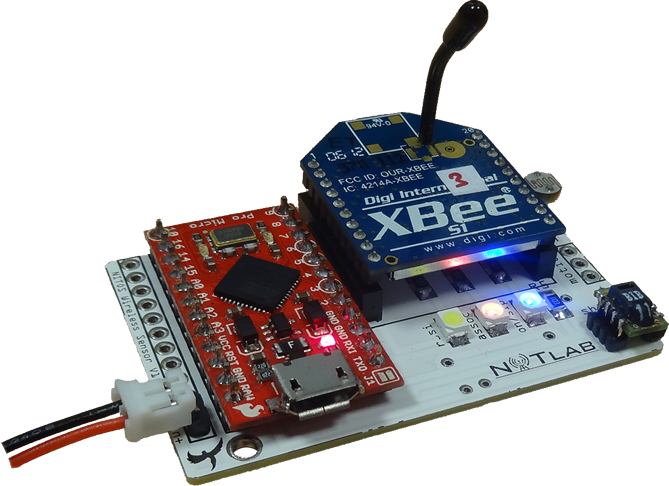Articles
NITOS Wireless Sensor Platform (2)

Figure 1: NITOS Wireless Sensor Prototype
Towards the direction of enabling sensing based on WSN solutions, NITLab [1] has developed a prototype wireless sensor platform comprised of open-source and configurable modules. The main part of the aforementioned platform is a Pro Micro [2] board, fabricated by Sparkfun Electronics [3], which provides open-source prototyping platforms, fully configurable by Arduino's [4] open-source software. The on-board AVR micro-controller developed by Atmel [5], runs at 8Mhz and coordinates the overall platform operation. Moreover, the platform is equipped with a Xbee [6] radio interface that enables communication with a respective gateway. The Xbee module is a tiny device ideal for setting up mesh networks and has a defined rate of 250 kbps. This module uses the IEEE 802.15.4 stack (the basis for Zigbee[zigbee1]) and wraps it into a simple to use serial command set, allowing a very reliable and simple communication with Pro Micro's micro-controller. The developed platform currently features a number of sensing modules, such as air temperature and humidity, light intensity and human presence. Various types of sensing modules and actuators can be further integrated utilizing Arduino libraries that implement several existing communications protocols, such as I2C, LIN, SPI, TWI, USI, etc. Firmware can be easily uploaded through the on-board USB connection. In addition to this, the developed platform supports over-the-air-programming achieved by a special circuit integrated in the PCB, allowing firmware to be uploaded wirelessly. Apart from the pluggable Xbee module, the developed platform can be equipped with WiFi or Bluetooth radio interfaces compatible with Xbee footprint, thus enabling communication utilizing different technology standards. By exploiting open-source firmware, developers can define different network topologies according to their experimentation setup, while numerous aggregation schemes can be used for gathering information reducing the total communication cost. Furthermore, the developed platform is a low-cost and small-sized one that can be powered by low-voltage sources, making it ideal for extended deployment at almost any place.

Figure 2: NITOS Wireless Sensors Gateway
In order to enable communication with the developed wireless sensor platform we have created a respective gateway node. To this aim we have utilized Arduino Etherner board w/o PoE [8], which is an Arduino micro-controller board featuring also an Ethernet Interface controlled by Wiznet 5100 [9]. The developed gateway can be programmed through Arduino IDE and can be configured to act as a Web Server that serves http requests. In essence, the developed gateway enables communication between the IEEE 802.15.4 network and the User/Server.
References:
[1] Network Implementation Testbed Laboratory : http://nitlab.inf.uth.gr/NITlab/
[2] Pro Micro Board : https://www.sparkfun.com/products/10999
[3] Sparkfun Electronics : https://www.sparkfun.com/
[4] Arduino : http://www.arduino.cc/
[5] Atmel Corporation : http://www.atmel.com/
[6] Xbee radio interfaces : http://www.digi.com/xbee/
[7] ZigBee Alliance : http://www.zigbee.org/
[8] Arduino Ethernet Board : http://arduino.cc/en/Main/ArduinoBoardEthernet
[9] Wiznet 5100 Ethernet Controller : http://www.wiznet.co.kr/Sub_Modules/en/product/Product_Detail.asp?cate1=5&cate2=7&cate3=26&pid=1011


